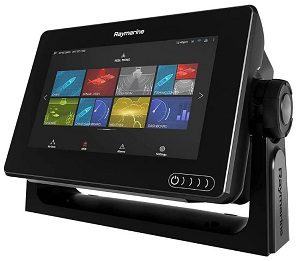
Not knowing how it works, what more can you expect despite only wasting the time on the boat?
The better you know, you can control your fish-catching rate and get back onshore on time with prejudice and celebration.
And when you use these highly-impactful Raymarine fish finders for the first time, expect a boost in your fishing experience.
Talking deeply about the Raymarine fish finders, the good thing is they are exclusively low-price than the reputable fishfinder brands but do not question their operation. Once you start using them, you will never find any indifference in the results, at least.
How to Read a Raymarine Fish Finder
What we like the most with Raymarine fishfinder is the clear, enhanced, and detailed display. What is shown there, the impeccable quality view is enough to differentiate the bottom objects, fish, and anything.
Using the Raymarine fishfinder does not need you to be a full-blown experienced angler. Operating any fish finders from Raymarine is actually quite handy.
The MultiFunctional Display to Better Identify the Fish
And the good thing about (many) Raymarine fish finders is they (mostly) come with a multifunctional display where you can use two different sonar technologies to get better results while identifying the fish and the waterbed.
The old traditional 2D sonar technology still works but it can sometimes puzzle you, especially with the school of fish and the large area covering the vegetation.
Thanks to the multifunctional fish finders, the ability to switch the fish detection in icons and arches tells exactly if the fish is a fish in real life.
Spotting the fish using an arch requires experience which you can easily hold after a couple of fishing adventures.
With fish icons, you know the possible size and can easily distinguish the objects on the waterbed without any difficulty.
Know the Depth for Your Own Good!
The depth is the primary part to make your fishing trip a success because the different fish species tend to hurl on the specific depth So, Raymarine fish finders do not lack this noteworthy feature at all.
Easy Readable Speed
Okay, no boat lacks the speedometer installed on the cockpit but why read it all the time when you can effectively and clearly read it from the fish finder?
Cruising at the turtle’s speed or chasing the fast-moving shark, the speed will be shown to its truest setting right on the fishfinder’s display for utter convenience (that too in digital form.)
The built-in speedometer cannot give a proper track of the super-low speed i.e., below 3mph, 2mph, and under 1mph, so the digital speed data tells a tenth of a mile per hour.
And the good thing is, it does not tell the speed but measures in SOG (Speed on Ground) which is the true speed setting where the boat will still be drifting on its own even though the engine is off.
Water and Voltage
The water here represents the temperature to get a hunch of how cold or warm the water is.
Since the Raymarine fishfinders are directly connected to the boat’s electrical system, the Voltage reading tells your whole system is getting enough acceptable power to make it run at the optimum level.
Dropping or rising in the current supply spotted, it is time to get your electrical connections checked.
Power of Zoom
Not common in many fish finders but if yours feature zoom then you are in pure luck!
And that makes it easy to distinguish whether the fish is hiding behind the vegetation giving you a hunch there would not be anything down there.
Conclusion!
Gladly speaking, the Raymarine fishfinders are pretty affordable, giving you the exact same features all the noteworthy fishfinder brands offer to the mass.
And how to read a Raymarine fish finder impacts directly your fishing skill (on a positive side), and we bet you would not find any problem operating it.
So, fish with a Raymarine fish finder and see your fishing skill improving’! 🙂
- What Do You Need for Fishing - August 18, 2022
- How to Find Offshore Fishing Spots - August 18, 2022
- What to Use for Trout Fishing - August 17, 2022
